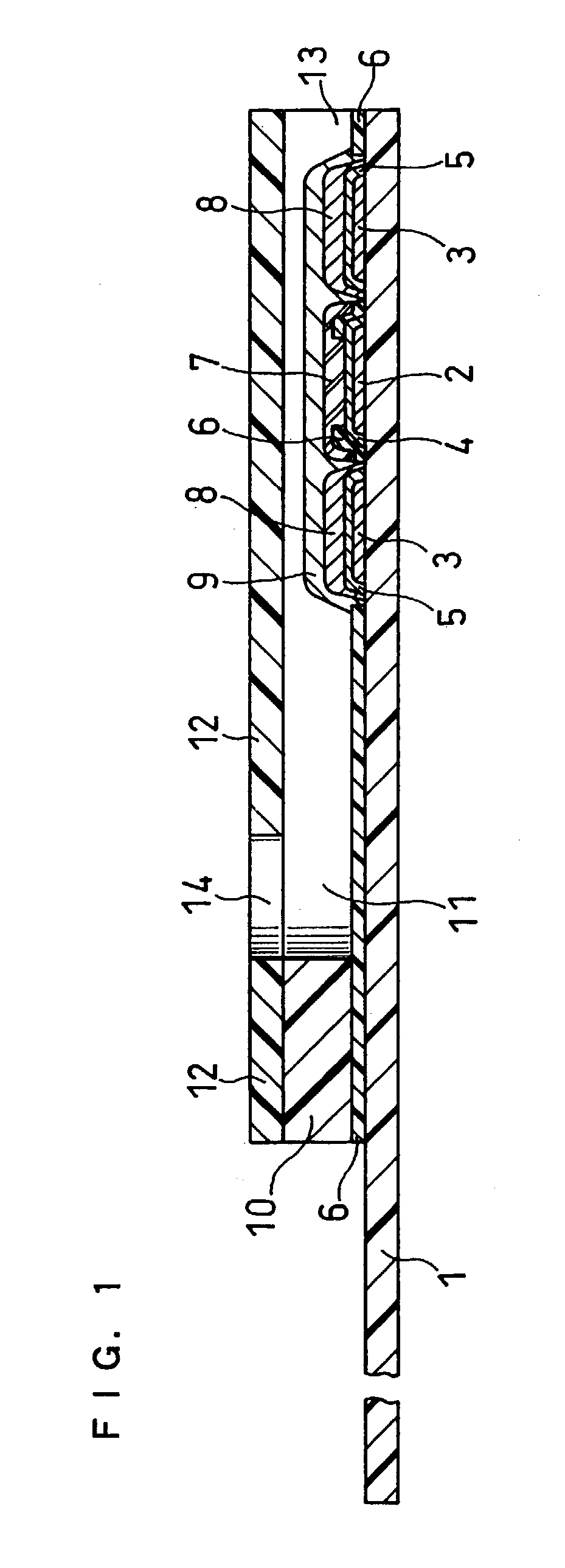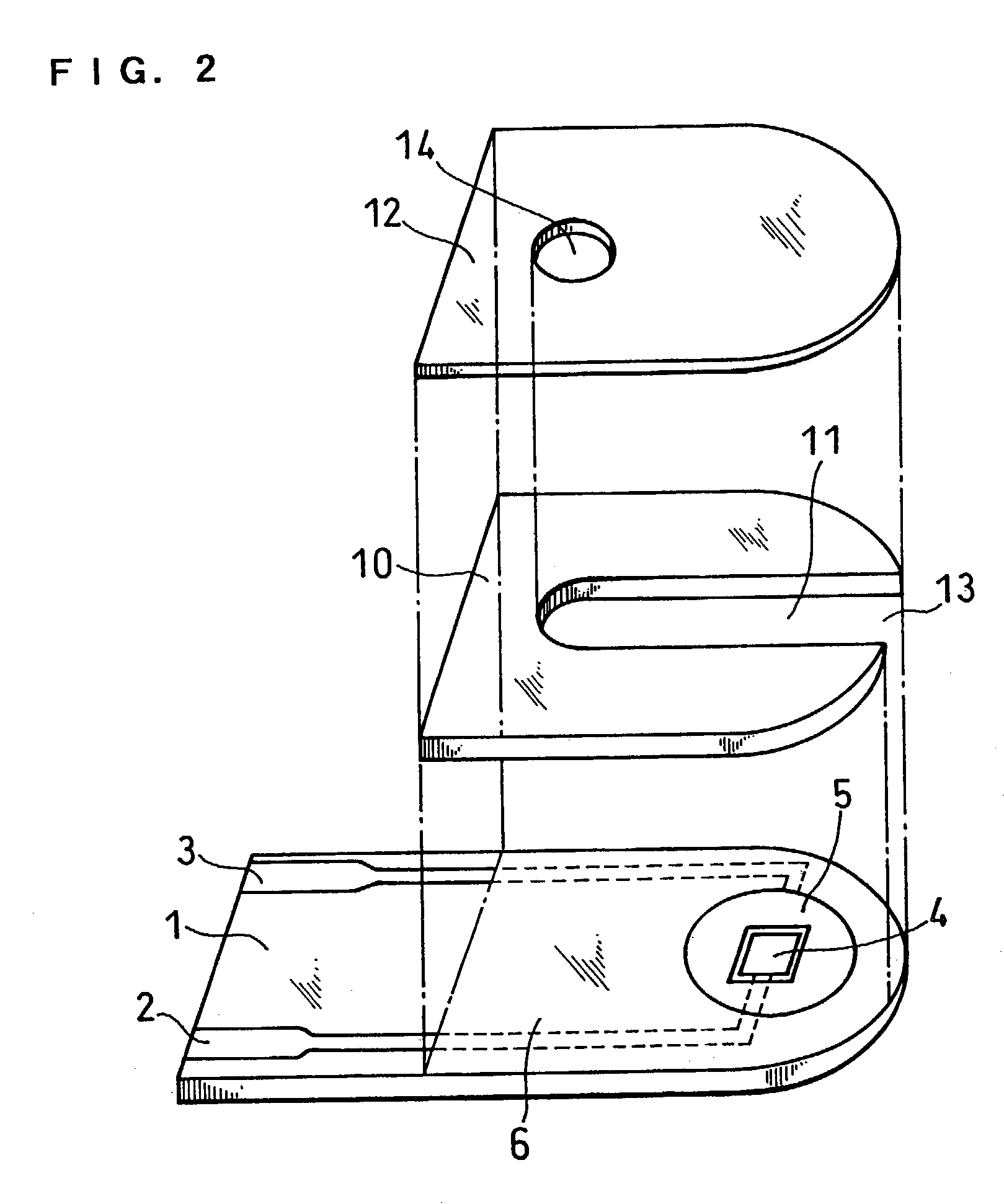Biosensor
a biosensor and sensor technology, applied in the field of biosensors, can solve the problems of poor accuracy, poor specificity of sugar methods, and inability to measure sugar at home by ordinary peopl
- Summary
- Abstract
- Description
- Claims
- Application Information
AI Technical Summary
Benefits of technology
Problems solved by technology
Method used
Image
Examples
example 1
[0040]A glucose sensor will be explained as an example of a biosensor.
[0041]FIG. 1 is a vertical cross-sectional view of a glucose sensor of this example, and FIG. 2 is an exploded perspective view of the glucose sensor, omitting the reagent layers and surface active agent layer therefrom.
[0042]First, a silver paste was printed on an electrically insulating base plate 1 made of polyethylene terephthalate by screen printing to form leads 2 and 3 and the base of later-described electrodes. Then, a conductive carbon paste containing a resin binder was printed on the base plate 1 to form a working electrode 4. This working electrode 4 was in contact with the lead 2. Further, an insulating paste was printed on the base plate 1 to form an insulating layer 6. The insulating layer 6 covered the peripheral portion of the working electrode 4 so that a fixed area of the working electrode 4 was exposed. Next, a counter electrode 5 was formed by printing a conductive carbon paste containing a re...
example 2
[0053]FIG. 3 is a vertical cross-sectional view of a glucose sensor of this example, and FIG. 4 is an exploded perspective view of the glucose sensor, omitting the reagent layers and surface active agent layer therefrom.
[0054]A working electrode 4 and a lead 2 were formed by sputtering palladium on an electrically insulating base plate 21. Next, by pasting an insulating sheet 23 on the base plate 21, the working electrode 4 and a terminal section to be inserted into a measurement device were defined.
[0055]Meanwhile, a counter electrode 5 was formed by sputtering palladium onto the inner wall surface of an outwardly expanded curved section 24 of an electrically insulating cover member 22. An end portion of the curved section 24 was provided with an air vent 14.
[0056]A first aqueous solution containing GOD as an enzyme and no electron mediator was dropped on the working electrode 4 of the base plate 21 and then dried to form a first reagent layer 7. Besides, a second aqueous solution ...
example 3
[0060]FIG. 5 is a vertical cross-sectional view of a glucose sensor of this example, and FIG. 6 is an exploded perspective view of the glucose sensor, omitting the reagent layers and surface active agent layer therefrom.
[0061]First, a silver paste was printed on an electrically insulating base plate 31 made of polyethylene terephthalate by screen printing to form a lead 2. Then, a conductive carbon paste containing a resin binder was printed on the base plate 31 to form a working electrode 4. This working electrode 4 was in contact with the lead 2. Further, an insulating paste was printed on the base plate 31 to form an insulating layer 6. The insulating layer 6 covered the peripheral portion of the working electrode 4 so that a fixed area of the working electrode 4 was exposed.
[0062]Next, a silver paste was printed on the inner surface of an electrically insulating cover 32 to form a lead 3, and then a conductive carbon paste was printed to form a counter electrode 5. Further, an i...
PUM
| Property | Measurement | Unit |
|---|---|---|
| voltage | aaaaa | aaaaa |
| electrically insulating | aaaaa | aaaaa |
| hydrophilic | aaaaa | aaaaa |
Abstract
Description
Claims
Application Information
 Login to View More
Login to View More - R&D
- Intellectual Property
- Life Sciences
- Materials
- Tech Scout
- Unparalleled Data Quality
- Higher Quality Content
- 60% Fewer Hallucinations
Browse by: Latest US Patents, China's latest patents, Technical Efficacy Thesaurus, Application Domain, Technology Topic, Popular Technical Reports.
© 2025 PatSnap. All rights reserved.Legal|Privacy policy|Modern Slavery Act Transparency Statement|Sitemap|About US| Contact US: help@patsnap.com



